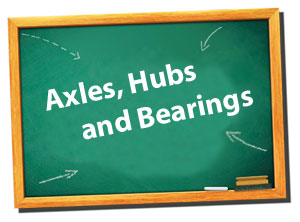 HOME | 1 | 2 | |
||||
Pontoon Trailer: Axles, Hubs & Bearings cont... |
||||
| Hubs and Bearings | ||||
|
Trailer wheels turn on
spindles and hubs. The end
of the axle has a polished
shaft with a threaded nut on
the end. This is called a
spindle. Bearings rotate in
polished units called races.
A hub that has wheel studs
is attached by a bolt and
covered with a cap. About
the only variation in these
assemblies is the type of
dust cap. Some pontoon
trailers have a grease zerk
designed into the dust cap
(sometimes called a Bearing
Buddy). Others have a grease
zerk beneath the dust cap,
often under a protective
rubber cap. |
||||
 Pontoon Trailer Axle "End Unit" |
||||
| 1. Seal | 2. Inner Bearing | 3. Inner Race | 4. Outer Bearing | 5. Outer Race | 6. Hub | 7. Dust Cap | 8. Spindle | 9. Lug nut | ||||
| Hubs are rated by their carrying capacity and have to meet certain Department of Transportation requirements for the rating. Thus a “cheap” hub with imported bearings (and most of them are imported) will do what its supposed to do, even though it’s not a known “national” brand. | ||||
| Size Matters | ||||
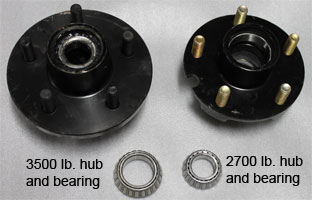 Some
manufacturers are always
cutting corners on pontoon
trailers: bias ply tires,
incandescent lighting, and
cheap axles. It’s my opinion
all pontoon trailers should
have 3500 lb. axles. But
2700 lb. or sometimes even
2000 lb. axles are used. The
cost difference isn’t
substantial but a fishing
boat trailer manufacturer
that builds pontoon trailers
may use axles they have in
stock. The difference is in
the size of the hubs and
bearings. A comparison of
the 2700 lb. hub and 3500
lb. hub, shown above,
reveals the difference.
Larger hubs and bearings
dissipate heat better, they
run cooler, and don’t burn
up grease as fast. If you’re
running small tires on 2700
lb. axles you’ll need to
grease the bearings more
often than bigger tires.
Most trailer owners forget
about maintenance and if you
don’t grease the bearings
you’ll realize you have a
problem when you start
seeing smoke. When buying a
new trailer it’s a good idea
to pop the dust cap and
check the grease. You won’t
actually be able to see
grease inside the hub but a
little residue on the zerk
is reassuring. Some
manufacturers are always
cutting corners on pontoon
trailers: bias ply tires,
incandescent lighting, and
cheap axles. It’s my opinion
all pontoon trailers should
have 3500 lb. axles. But
2700 lb. or sometimes even
2000 lb. axles are used. The
cost difference isn’t
substantial but a fishing
boat trailer manufacturer
that builds pontoon trailers
may use axles they have in
stock. The difference is in
the size of the hubs and
bearings. A comparison of
the 2700 lb. hub and 3500
lb. hub, shown above,
reveals the difference.
Larger hubs and bearings
dissipate heat better, they
run cooler, and don’t burn
up grease as fast. If you’re
running small tires on 2700
lb. axles you’ll need to
grease the bearings more
often than bigger tires.
Most trailer owners forget
about maintenance and if you
don’t grease the bearings
you’ll realize you have a
problem when you start
seeing smoke. When buying a
new trailer it’s a good idea
to pop the dust cap and
check the grease. You won’t
actually be able to see
grease inside the hub but a
little residue on the zerk
is reassuring. |
||||
| Oil Filled Hubs | ||||
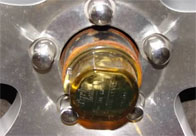 I’m one to embrace new technology, LED lights, radial tires, disc brakes, etc. We experimented with the oil filled hub and decided that it didn’t make sense for most pontoon trailers. You can search the internet for the benefits and disadvantages. If you are towing frequently and require excellent bearing lubrication, oil filled hubs have benefits. When not towing, condensation can form. They require maintenance and most pontoon trailer owners are not looking for something extra to do. |
||||
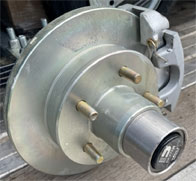 The problem with oil filled hubs on an 8’ wide pontoon axle is they are easily knocked off. The oil reservoir sticks out from the hub. Wide axle trailer can hit a curb or dealers moving a trailer will damage the reservoir. This is a common occurrence, we sell dozens of inexpensive replacement dust covers for grease axles a year. When you knock the end unit of a oil filled hub off, it’s a trip to a mechanic to replace the system, (Vault Service kit $219.57 on eBay). |
||||
| How to Grease the Bearings | ||||
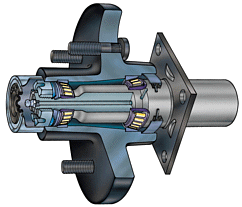 |
 |
|||
|
Most spindles have a grease
zerk on the end for easy
maintenance. There are
varying types of dust
covers. The common style has
a rubber cap that covers a
hole, you pop out the rubber
cap and the grease zerk is
beneath. Some manufacturers
have special designs and you
don’t need to remove the
rubber cap. I prefer the
style where you put the
grease gun directly into the
grease zerk. With the “zerk
in the dust cap” style there
can be doubt if the inner
and outer grease zerks are
lined up properly. If they
are not lined up all you do
is fill the dust cap with
grease. Some manufacturers
have a closed dust cap that
you have to remove to grease
the bearings. A word of advice in case of a break down. Brand names are usually reassuring to the consumer: Reliable, Dexter, etc. There is however a catch. If you break down and damage the bearings you may have a difficult time finding parts. You may need to contact the trailer manufacturer and have them send you the parts. Many manufacturers buy parts from large distributors. If you breakdown in some remote area you can often go to an auto parts store and buy bearings and a hub. If you have a brand that uses proprietary (hubs made special for their trailers) you may have a wait for repair parts. If you’re going on a long trip, smart individuals will take a spare tire. But a spare hub is a better idea. Hubs cost less than a spare tire and if you have trouble on the road almost any handyman or repair shop can replace trailer bearings or a hub. |
||||
| HOME | 1 | 2 | | ||||
| PONTOON TRAILERS 101 - FOR EVERYTHING YOU NEED TO KNOW ABOUT PONTOON BOAT TRAILERS | ||||
